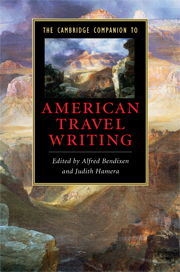Book contents
- Frontmatter
- Introduction: new worlds and old lands - the travel book and the construction of American identity
- Part I Confronting the American landscape
- 1 Beginnings: the origins of American travel writing in the pre-revolutionary period
- 2 “Property in the horizon”: landscape and American travel writing
- 3 New York to Niagara by way of the Hudson and the Erie
- 4 The Mississippi River as site and symbol
- 5 The Southwest and travel writing
- Part II Americans abroad
- Part III Social scenes and American sites
- Chronology
- Further Reading
- Index
5 - The Southwest and travel writing
from Part I - Confronting the American landscape
Published online by Cambridge University Press: 28 March 2009
- Frontmatter
- Introduction: new worlds and old lands - the travel book and the construction of American identity
- Part I Confronting the American landscape
- 1 Beginnings: the origins of American travel writing in the pre-revolutionary period
- 2 “Property in the horizon”: landscape and American travel writing
- 3 New York to Niagara by way of the Hudson and the Erie
- 4 The Mississippi River as site and symbol
- 5 The Southwest and travel writing
- Part II Americans abroad
- Part III Social scenes and American sites
- Chronology
- Further Reading
- Index
Summary
In August 1830 James Ohio Pattie traveled back to the United States after a five-year odyssey through the mountains, canyonlands, and arid plains of the region between Santa Fe, New Mexico and San Diego, California. He had set out to make a fortune in the fur trade, but returned with neither money nor possessions. The only asset he possessed was the remarkable story of his extensive travels. He collaborated with Timothy Flint, whose frontier histories include a biography of Daniel Boone and a novel set in New Mexico, to produce The Personal Narrative of James O. Pattie (1831), one of the earliest American-authored works in which the Southwest is described. The book records a relentless slaughter of beaver, bears, and buffalo, and details frequent interactions with Native Americans that vary from mutual accommodation to outright violence. While the factual value of the account is in parts suspect, Pattie's frontier narrative nevertheless provides fascinating insights into a region that was little known to Americans until the 1820s and 1830s.
- Type
- Chapter
- Information
- The Cambridge Companion to American Travel Writing , pp. 78 - 100Publisher: Cambridge University PressPrint publication year: 2009

